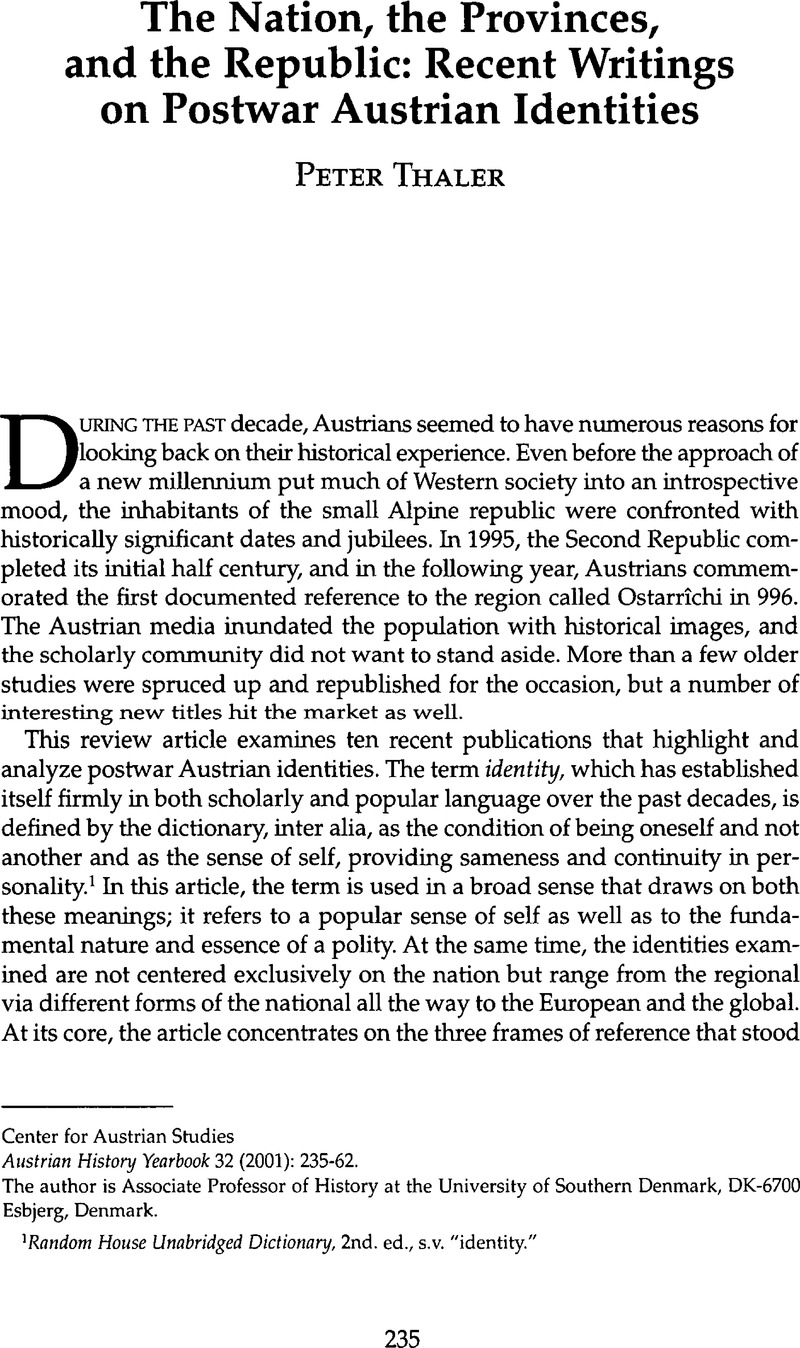No CrossRef data available.
Published online by Cambridge University Press: 10 February 2009

1 Random House Unabridged Dictionary,2nd. ed., s.v. “identity.”
2 Werner, Suppanz, Österreichische Geschichtsbilder. Historische Legitimationen in Ständestaat und Zweiter Republik (Vienna, 1998).Google Scholar
3 The terms Germanist and Austrianist refer to the two historically competing identity conceptions in Austria. The Germanist conception views Austrian identity as part of a larger German identity, however defined, whereas its Austrianist counterpart rejects the affiliation of Austrian with any form of German identity.
4 Austria's political system was traditionally divided into three compering subcultures, which have been termed Lager in an allusion to the military camps of historic warfare: the Social Democratic camp, the Catholic–Conservative camp, and the National–Liberal camp. To reflect the party–like significance of these political subcultures and to enhance clarity, the designations of these camps are capitalized. The names of individual parties within these traditions underwent repeated changes.
5 Max, Haller, ed., Identität und Nationalstolz der Österreicher (Vienna, 1996).Google Scholar
6 Since the books reviewed reflect a wider Austrian tendency to locate regional history at the level of individual provinces, the terms regional and provincial are used interchangeably here. It should be emphasized, however, that regional history can and should examine a variety of cultural spheres, as will become clear in the course of this article as well.
7 The Austrian Bundesländer, which are constituent parts of a federal state, are referred to as provinces in this article. They correspond to American states, but the ambiguity of the word state made it preferable to use the Canadian terminology.
8 Ernst, Bruckmiiller, Nation Österreich. Kulturelles Bewufitsein und gesellschaftlich–politische Prozesse, 2nd ed., rev. and enl. (Vienna, 1996).Google Scholar
9 Emphasis in the original. The translations of this and subsequent German sources are my own.
10 See Haller, Identität und Nationalstolz der Österreicher, 401.
11 For the numbers, see Dr. Fessel & CO, “Österreichbewufitsein 1987,” 23.
12 In all likelihood, additional volumes will have been published by the time this article appears.
13 Ernst, Hanisch and Robert, Kriechbaumer, eds., Salzburg. Zwischen Globalisierung und Goldhaube (Vienna, 1997),Google Scholar vol. 1 of Geschichte der österreichischen Bundesländer seit 1945, ed. Herbert, Dachs, Ernst, Hanisch, and Robert, Kriechbaumer.Google Scholar
14 The acronym SPÖ stood for Sozialistische Partei Österreichs in the earlier postwar era but currently stands for Sozialdemokratische Partei Österreichs.
15 Helmut, Rumpler, ed., Kärnten. Von der deutschen Grenzmark zum österreichischen Bundesland (Vienna, 1998),Google Scholar vol. 2 of Geschichte der österreichischen Bundesländer seit 1945, ed. Dachs, , Hanisch, , and Kriechbaumer, .Google Scholar
16 For the assessment of different levels of identity in Austria, see also the Fessel study “ÖsterreichbewuGtsein 1987.”
17 Michael, Gehler, ed., Tirol. “Land im Gebirge”. Zwischen Tradition und Moderne (Vienna, 1999),Google Scholar vol. 3 of Geschichte der österreichischen Biindesländer serf 1945, ed. Dachs, , Hanisch, , and Kriechbaumer, .Google Scholar
18 See Hans, Weigel, O du mein Österreich. Versuch und Fragment einer Improvisation för Anfänger und solche, die es werden wollen, 5th ed. (Stuttgart, 1962), 134, 180.Google Scholar
19 Alfred, Elste and Dirk, Hanisch, Kärnten von der Ersten zur Zweiten Republik. Kontinuität oder Wandel (Klagenfurt, 1998).Google Scholar
20 Among them are Alfred, Elste, Kärntens braune Elite (Klagenfurt, 1997),Google Scholar and Alfred, Elste and Dirk, Hänisch, Auf dem Weg zur Macht. Beiträge zur Geschichte der NSDAP in Kärnten von 1918 bis 1938 (Vienna, 1997).Google Scholar
21 The weaknesses surface in results that show, for example, that voters supporting “other parties” in 1949 were overrepresented by a factor of twenty–four among the voters supporting such parties in 1953 (215), which highlights the optical distortions contained in such calculations with regard to smaller groups and the necessity to relativize such findings in comparable settings.
22 Because of procedural problems, the newly formed Verband der Unabhangigen (League of Independents, VdU) had to contest its early elections under the name of Wahlverband der Unabhangigen (WdU). It was succeeded by the Freedom Party in the mid–1950s.
23 This problematique forms a recurrent issue in Friedrich, Heer's great study, Der Kampfum die österreichische Identität (Vienna, 1981).Google Scholar
24 Luther, Kurt Richard and Peter, Pulzer, eds., Austria T945–95: Fifty Years of the Second Republic (Aldershot, 1998).Google Scholar
25 Anton, Pelinka, Austria: Out of the Shadow of the Past (Boulder, Colo., 1998). The study is part of Westview's series on the nations of the modern world.Google Scholar
26 Herbert, Dachs, Peter, Gerlich, and Möller, Wolfgang C., eds., Die Politiker. Karrieren und Wirken bedeutender Repräsentanten der Zweiten Rqiublik (Vienna, 1995).Google Scholar
27 Thomas, Angerer, “An Incomplete Discipline: Austrian Zeitgeschichte and Recent History,” in Austria in the Nineteen Fifties, ed. Günter, Bischof and Anton, Pelinka, Contemporary Austrian Studies 3 (New Brunswick, N.J., 1995), 212.Google Scholar